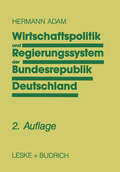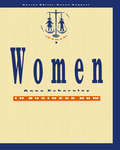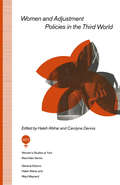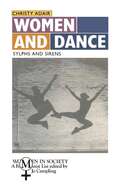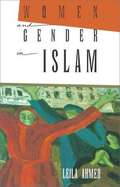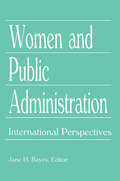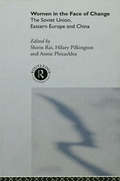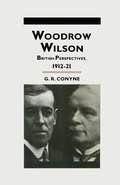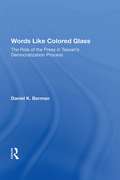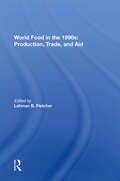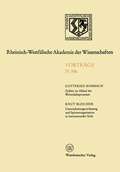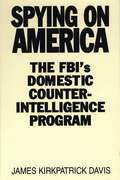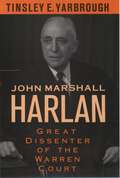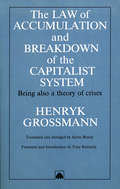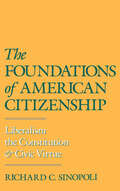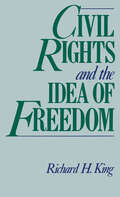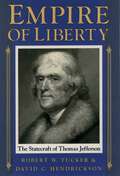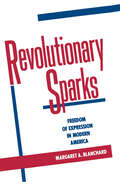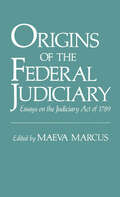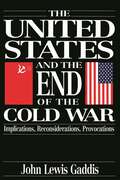- Table View
- List View
Wirtschaftspolitik und Regierungssystem der Bundesrepublik Deutschland: Eine Einführung
by Hermann AdamWirtschaft und Politik sind für viele ein Buch mit sieben Siegeln. Kompli ziert und undurchschaubar erscheinen Ihnen die Vorgänge "da oben", die das Leben von uns allen positiv wie negativ beeinflussen. Dabei möchte ei gentlich jeder gerne verstehen, wie es zu Wirtschaftskrisen kommt, warum so viele Menschen arbeitslos sind, weshalb die Preise jedes Jahr steigen, kurz: wie das alles miteinander zusammenhängt. Die auf dem Markt befindlichen Einführungen in die Volkswirtschafts lehre füllen mittlerweile ganze Bibliotheksregale. Wer jedoch nicht Wirt schaftswissenschaften studiert und Wirtschaft zu seinem Beruf machen will, kann mit diesen meist sehr theoretisch gehaltenen Werken wenig an fangen. Er braucht knappe und einfache Erklärungen, wie die Wirtschaft funktioniert und wie die wirtschaftspolitischen Positionen von Regierung und Opposition, von Parteien und Verbänden einzuordnen und zu beurtei len sind. Diesem Anspruch einer praxisnahen und allgemeinverständlichen Ein führung in die grundlegenden Zusammenhänge von Politik und Wirtschaft in der Bundesrepublik Deutschland will dieses Buch gerecht werden. Es wendet sich an alle, die wirtschaftspolitische Nachrichten in den Massen medien besser verstehen und bei einschlägigen Diskussionen sachkundig mitreden wollen.
Women and Adjustment Policies in the Third World (Women's Studies at York Series)
by Haleh Afshar Carolyne DennisThe Third World debt crisis, the International Monetary Fund and World Bank's adjustment policies have compelled many countries to move towards a contraction of public sector expenditure in favour of market orientated development policies. Women in general and the poorest amongst them in particular have borne a disproportionate burden of the ensuing hardships. This book addresses the shortcomings in the current gender blind analytical frameworks of governments and financial organisations and offers alternative strategies for combating recession and poverty.
Women and Dance: Sylphs and Sirens (Women in Society: A Feminist List)
by Christy AdairA broad-ranging account of women's roles and experience in dance, which demolishes the myth that dance is a female art form by demonstrating the way in which it is dominated by male managers, choreographers and directors. While most dancers are women, for the most part they interpret male-constructed images rather than create their own. This is not inevitable, however, the author argues; dance is a possible arena for feminist practice and women's liberation.
Women and Gender in Islam: Historical Roots of a Modern Debate (PDF)
by Leila AhmedAre Islamic societies inherently oppressive to women? Is the trend among Islamic women to appear once again in veils and other traditional clothing a symbol of regression or an effort to return to a "pure" Islam that was just and fair to both sexes? In this book Leila Ahmed adds a new perspective to the current debate about women and Islam by exploring its historical roots, tracing the developments in Islamic discourses on women and gender from the ancient world to the present. In order to distinguish what was distinctive about the earliest Islamic doctrine on women, Ahmed first describes the gender systems in place in the Middle East before the rise of Islam. She then focuses on those Arab societies that played a key role in elaborating the dominant Islamic discourses about women and gender: Arabia during the period in which Islam was founded; Iraq during the classical age, when the prescriptive core of legal and religious discourse on women was formulated; and Egypt during the nineteenth and twentieth centuries, when exposure to Western societies led to dramatic social change and to the emergence of new discourses on women. Throughout, Ahmed not only considers the Islamic texts in which central ideologies about women and gender developed or were debated but also places this discourse in its social and historical context. Her book is thus a fascinating survey of Islamic debates and ideologies about women and the historical circumstances of their position in society, the first such discussion using the analytic tools of contemporary gender studies.
Women and Public Administration: International Perspectives
by Jane H BayesThis new book is the result of an international research project that spanned nearly a decade. Authors from a half-dozen countries discuss women's roles in public administration in the context of their overall participation in the labor force. Women and Public Administration presents some astounding results derived from the authors’research into a particular country's government, politics, and the role of women in that country. The authors, women born and currently living in India, Bulgaria, the Netherlands, Germany, Finland, and the United States, discuss four main topics: the number and level of female civil servants in the highest ranks of at least two bureaucracies, one concerned with traditionally female roles and one concerned with traditionally male roles; the career histories of these women; an institutional description of women in public bureaucracies; and the perceptions of women in public administration concerning discrimination and equality policies. This important book also describes historical, demographic, economic, and governmental information and women's views of barriers, access to training and advancement, and the general social climate for women employees at various levels within the bureaucracies.Researchers, aware of cultural and language differences and the dangers of imposing a Western model on non-Western cultures, used questionnaires and interviews to obtain much of the information for this study. Each country has its own unique story involving history, the structure of the labor market, the organization of government, and the socialization patterns of the culture, as well as the current patterns of interaction between men and women and current public policies affecting these matters. Women and Public Administration contains much valuable information for everyone interested in women's roles in bureaucracies around the world.
Women and Public Administration: International Perspectives
by Jane H BayesThis new book is the result of an international research project that spanned nearly a decade. Authors from a half-dozen countries discuss women's roles in public administration in the context of their overall participation in the labor force. Women and Public Administration presents some astounding results derived from the authors’research into a particular country's government, politics, and the role of women in that country. The authors, women born and currently living in India, Bulgaria, the Netherlands, Germany, Finland, and the United States, discuss four main topics: the number and level of female civil servants in the highest ranks of at least two bureaucracies, one concerned with traditionally female roles and one concerned with traditionally male roles; the career histories of these women; an institutional description of women in public bureaucracies; and the perceptions of women in public administration concerning discrimination and equality policies. This important book also describes historical, demographic, economic, and governmental information and women's views of barriers, access to training and advancement, and the general social climate for women employees at various levels within the bureaucracies.Researchers, aware of cultural and language differences and the dangers of imposing a Western model on non-Western cultures, used questionnaires and interviews to obtain much of the information for this study. Each country has its own unique story involving history, the structure of the labor market, the organization of government, and the socialization patterns of the culture, as well as the current patterns of interaction between men and women and current public policies affecting these matters. Women and Public Administration contains much valuable information for everyone interested in women's roles in bureaucracies around the world.
Women in the Face of Change: Soviet Union, Eastern Europe and China
by Shirin Rai Hilary Pilkington Annie PhizackleaFirst Published in 1992. Routledge is an imprint of Taylor & Francis, an informa company.
Women in the Face of Change: Soviet Union, Eastern Europe and China
by Annie Phizacklea Hilary Pilkington Shirin RaiFirst Published in 1992. Routledge is an imprint of Taylor & Francis, an informa company.
Woodrow Wilson: British Perspectives, 1912–21 (Studies in Military and Strategic History)
by G.R. ConyneThis is a narrative study of British diplomatic perceptions of Woodrow Wilson during his presidential campaign and presidency. Using archival material not previously explored for this purpose, George Conyne is able to challenge the conventional view of British reactions to Wilson and American policy at the Paris Peace Conference. He casts fresh light on the sources and the consequences of their image of the president of the United States.
Words Like Colored Glass: The Role Of The Press In Taiwan's Democratization Process
by Daniel K BermanA study of the contribution of the Press to the democratization process in Taiwan. Combining ideas from political science, communication theory and Chinese studies, the author challenges conventional wisdom on the subject.
Words Like Colored Glass: The Role Of The Press In Taiwan's Democratization Process
by Daniel K BermanA study of the contribution of the Press to the democratization process in Taiwan. Combining ideas from political science, communication theory and Chinese studies, the author challenges conventional wisdom on the subject.
World Food In The 1990s: Production, Trade, And Aid
by Lehman FletcherIn this book contributors from various scholarly backgrounds interpret past trends in world food trade, aid and security and propose new policy options for the 1990s. They address the problems facing the distribution of global economic growth and trade between industrialized and developing countries while exploring the effects that supply, demand, assistance programmes, foreign aid and other policy variables have on the evolving world trade and food system. This book should prove of interest to a range of scholars and policymakers dealing with food, health, human rights, Third World development, agricultural economics, international political economy and trade policy.
World Food In The 1990s: Production, Trade, And Aid
by Lehman FletcherIn this book contributors from various scholarly backgrounds interpret past trends in world food trade, aid and security and propose new policy options for the 1990s. They address the problems facing the distribution of global economic growth and trade between industrialized and developing countries while exploring the effects that supply, demand, assistance programmes, foreign aid and other policy variables have on the evolving world trade and food system. This book should prove of interest to a range of scholars and policymakers dealing with food, health, human rights, Third World development, agricultural economics, international political economy and trade policy.
Zyklen im Ablauf des Wirtschaftsprozesses Mythos und Realität. Unternehmungsverfassung und Spitzenorganisation in internationaler Sicht: 381. Sitzung am 5. Februar 1992 in Düsseldorf (Rheinisch-Westfälische Akademie der Wissenschaften #241)
by Gottfried BombachSpying on America: The FBI's Domestic Counterintelligence Program
by James Kirkpatrick DavisCOINTELPRO. An acronym for Counterintelligence Program, this is the code name the FBI gave to the secret operations aimed at five major social and political protest groups--the Communist party, the Socialist Workers Party, the Ku Klux Klan, black nationalist hate groups, and the New Left movement. Spying on America, the first book to chronicle all five of the operations, tells the story of how the FBI, from 1956 until COINTELPRO's exposure in 1971, expanded its domestic surveillance programs and increasingly employed questionable, even unlawful, methods in an effort to disrupt what amounts to virtually our entire social and political protest movement. Violations of citizens' constitutional rights were rampant, and the secret operations actually resulted in a number of deaths. At the time, neither the public nor the news media knew anything about COINTELPRO. In vivid detail, Spying on America demonstrates that the system of checks and balances designed to prevent such occurrences was simply not functioning--until an illegal act uncovered the secret activities.The book opens with the daring raid of a Media, Pennsylvania FBI office by a group that adeptly used its booty--about 1,000 classified documents--to make COINTELPRO operations public. The burglars, who called themselves the Citizen's Commission to Investigate the FBI, used sophisticated methods (the FBI never caught up with them), releasing copies of incriminating documents to the media at carefully timed intervals. Spying on America draws on newspaper and magazine articles, interviews with many of the people involved, and FBI memos to trace the historical beginnings and operating methods of COINTELPRO efforts against each of the five targeted groups. In vivid detail, the author re-creates the reactions of the bureau--including the subsequent policy changes--as well as the response of the news media and the resulting shift in public attitudes toward the FBI. Finally, Davis looks at the possibility of similar operations in the future. In the context of our current, heightened state of socio-political awareness, it is difficult to comprehend how so many unlawful deeds could have been committed without the public's knowledge. Spying on America makes us aware of how easily such activities can occur--and in doing so, helps us prevent them from happening again.
John Marshall Harlan: Great Dissenter of the Warren Court
by Tinsley E. YarbroughWhen David Souter was nominated by President Bush to the Supreme Court, he cited John Marshall Harlan as his model. It was an interesting choice. Admired by conservatives and deeply respected by his liberal brethren, Harlan was a man, as Justice William Brennan lamented, whose "massive scholarship" has never been fully recognized. In addition, he was the second Harlan to sit on the Court, following his grandfather--also named John Marshall Harlan. But while his grandfather was an outspoken supporter of reconstruction on a conservative court, the younger Harlan emerged as a critic of the Warren Court's liberal expansion of civil liberties. Now, in the first biography of this important but neglected jurist, Tinsley Yarbrough provides a detailed account of Harlan's life, from his privileged childhood to his retirement and death. Yarbrough examines the forces and events which shaped the Justice's jurisprudence--his early life and often complex family relationships, education at Princeton and Oxford, his work as a prosecutor during Prohibition, Republican Party activities, wartime service in the Army Air Force, and years as one of the nation's preeminent corporate lawyers (a career culminating in his defense of the du Pont brothers in the massive DuPont-GM antitrust suit). The book focuses, however, on Harlan's years on the high bench. Yarbrough weaves together discussions of the Justice's relations with his brethren, clerks, and staff, an examination of Harlan's role in the decision-making process on the Court, and an analysis of his jurisprudence. The Justice's approach to constitutional interpretation exalted precedent, deference to governmental power, and narrow decisions closely tied to case facts; but he also accepted an evolving, creative model of constitutional construction which permitted expansive readings of constitutional rights. Yarbrough's details Harlan's close relationship with Justice Frankfurter, showing how--despite their friendship and alliance--Harlan strongly marked out his own position, both personally and judicially, on the Warren and Burger courts. And he examines the substance and significance of his dissents in such famous cases as Miranda and the Pentagon Papers. Intensively researched, smoothly written, and incisively argued, Yarbrough's biography offers an absorbing account of the life and career of a great dissenter, hailed by admirers as a "lawyer's lawyer" and a "judge's judge." Coming at a time when the high court has begun to adopt many of Harlan's principles, this account provides an essential perspective on the Court, civil liberties, and a pivotal figure in the history of both.
The Law of Accumulation and Breakdown of the Capitalist System
by Henryk GrossmannHenryk Grossmann's influential work provides the key to a fuller understanding of Marx's theory of crisis.
The Foundations of American Citizenship: Liberalism, the Constitution, and Civic Virtue
by Richard C. SinopoliThis study of exemplary writings from the debates over the ratification of the 1787 Constitution deals with the American constitutional founders' understandings of citizenship and civic virtue. Discussion of these debates is set in an analytical and historical context, addressing the rationales for and the nature of civic allegiance in liberal political regimes. Sinopoli analyzes the development of a distinctly liberal political psychology from its origins in John Locke, Adam Smith, and David Hume through the American founding and traces its implications for the current American polity.
Civil Rights and the Idea of Freedom
by Richard H. KingFocusing attention on the political ideas that were influential as well as those that were central to the civil rights movement, this pathbreaking book examines not only written texts but also oral history interviews to establish a rich tradition of freedom that emerged from the movement. He also makes clear that, though liberal notions of freedom involving the absence of restrictions and equal protections were crucial to movement goals, the movement was as much about individual and collective self-transformation and political participation as it was about removal of barriers to social and political equality. Along the way figures such as Martin Luther King and Ella Baker, Stokely Carmichael and James Forman, and political thinkers such as Hannah Arendt and Frantz Fanon are discussed and analyzed. Civil Rights and the Idea of Freedom concludes that the civil rights movement helped revitalize the meaning of citizenship and the political importance of self-respect in the contemporary world with implications reaching beyond its original setting.
Empire of Liberty: The Statecraft of Thomas Jefferson
by Robert W. Tucker David C. HendricksonEmpire of Liberty takes a new look at the public life, thought, and ambiguous legacy of one of America's most revered statesmen, offering new insight into the meaning of Jefferson in the American experience. This work examines Jefferson's legacy for American foreign policy in the light of several critical themes which continue to be highly significant today: the struggle between isolationists and interventionists, the historic ambivalence over the nation's role as a crusader for liberty, and the relationship between democracy and peace. Written by two distinguished scholars, this book provides invaluable insight into the classic ideas of American diplomacy.
Revolutionary Sparks: Freedom of Expression in Modern America
by Margaret A. BlanchardThe governmental pledge to the American people is found in the First Amendment: "Congress shall make no law...abridging the freedom of speech, or of the press." Written more than two hundred years ago, these words now protect a wide range of expressive activity. A broad-gauged discussion of freedom of expression in America, this book begins by studying the period after the Civil War and Reconstruction when new and unsettling ideas appeared with great regularity on the American scene. So many of these ideas were floating around during this period that the nation's leaders often joined forces to repress aberrant notions. In response to such suppression, individuals seeking to better their lives through the expression of new ideas began to demand their rights to speak, write, and associate together to advance their points of view. Blanchard traces this contest for control through the Watergate scandal of the 1970s and the Reagan and early Bush administrations. Blanchard presents a lively discussion of freedom of speech ranging from questions of national security to those of public morality, from loyalty during times of national stress to the right to preach on a public street corner. Including examinations of controversies involving the press, the national government, the Supreme Court, and civil liberties and civil rights concerns, Revolutionary Sparks presents a strong case for the right of Americans to speak their minds and to have access to knowledge necessary for informed self-government.
Origins of the Federal Judiciary: Essays on the Judiciary Act of 1789
by Maeva MarcusThe Judiciary Act of 1789 established a federal court system, an experiment that became one of the outstanding features of American democracy. Yet little has been written about the origins of the Act. This volume of essays analyzes the Act from political and legal perspectives while enhancing our understanding of the history of the judiciary and its role in the constitutional interpretation.
The United States and the End of the Cold War: Implications, Reconsiderations, Provocations
by John Lewis GaddisThe Cold War ended with an exhilarating wave of events: the toppling of the Berlin Wall, the rise of the dissident poet Vaclav Havel, the revolution in Romania. Americans rejoiced at the dramatic conclusion of the long struggle. "But victories in wars--hot or cold--tend to unfocus the mind," writes John Gaddis. "It can be a dangerous thing to have achieved one's objectives, because one then has to decide what to do next." In The United States and the End of the Cold War, Gaddis provides a sharp focus on the long history of the Cold War, shedding new light on its sudden ending, as well as on what might come next. In this provocative, insightful book, Gaddis offers a number of thoughtful essays on the history of international relations during the last half century. His reassessments of important figures and themes from the Cold War are sometimes surprising. For example, he portrays John Foster Dulles and Ronald Reagan as far more flexible and perceptive statesmen than the missile-toting caricatures depicted in editorial cartoons. And he takes a second look at the importance of espionage and intelligence in Cold War history, a field often left to buffs and spy novelists. Most important, he focuses on the central elements in superpower relations. In an eloquent account of the American style of foreign policy in the twentieth century, for instance, he explores how Americans (having learned the lesson of Adolf Hitler) consistently equated the forms of foreign governments with their external behavior, assuming that authoritarian states would be aggressive states. He also analyzes the "tectonics" of Cold War history, demonstrating how long term changes in international affairs and Soviet bloc countries built up pressures that led to the sudden earthquakes of 1989. And along the way, Gaddis illuminates such topics as the role of morality in American foreign policy, the relevance of nuclear weapons to the balance of power, and the objectives of containment. He even includes (and criticizes) an essay entitled, "How the Cold War Might End," written before the dramatic events of recent years, to demonstrate how quickly the tide of history can overwhelm contemporary analysis. Gaddis concludes with a thoughtful consideration of the problems and forces at work in the post-Cold War world. Author of such works as The Long Peace and Strategies of Containment, John Lewis Gaddis is one of the leading authorities on postwar American foreign policy. In these perceptive, highly readable essays, he provides a fresh assessment of the evolution of the Cold War, and insight into the shape of things to come.

